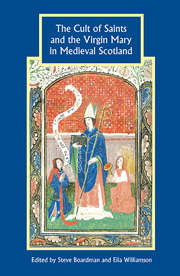Book contents
- Frontmatter
- Contents
- List of Illustrations and Tables
- List of Contributors
- Abbreviations
- Introduction
- 1 The Big Man, the Footsteps, and the Fissile Saint: paradigms and problems in studies of insular saints' cults
- 2 St Munnu in Ireland and Scotland: an exploration of his cult
- 3 The struggle for sanctity: St Waltheof of Melrose, Cistercian in-house cults and canonisation procedure at the turn of the thirteenth century
- 4 Royal and aristocratic attitudes to saints and the Virgin Mary in twelfth- and thirteenth-century Scotland
- 5 A saintly sinner? The ‘martyrdom’ of David, duke of Rothesay
- 6 Wo/men only? Marian devotion in medieval Perth
- 7 Is eagal liom lá na hagra: devotion to the Virgin in the later medieval Gàidhealtachd
- 8 Scottish saints' legends in the Aberdeen Breviary
- 9 Mothers and their sons: Mary and Jesus in Scotland, 1450–1560
- 10 The ‘McRoberts thesis’ and patterns of sanctity in late medieval Scotland
- Index
1 - The Big Man, the Footsteps, and the Fissile Saint: paradigms and problems in studies of insular saints' cults
Published online by Cambridge University Press: 05 October 2013
- Frontmatter
- Contents
- List of Illustrations and Tables
- List of Contributors
- Abbreviations
- Introduction
- 1 The Big Man, the Footsteps, and the Fissile Saint: paradigms and problems in studies of insular saints' cults
- 2 St Munnu in Ireland and Scotland: an exploration of his cult
- 3 The struggle for sanctity: St Waltheof of Melrose, Cistercian in-house cults and canonisation procedure at the turn of the thirteenth century
- 4 Royal and aristocratic attitudes to saints and the Virgin Mary in twelfth- and thirteenth-century Scotland
- 5 A saintly sinner? The ‘martyrdom’ of David, duke of Rothesay
- 6 Wo/men only? Marian devotion in medieval Perth
- 7 Is eagal liom lá na hagra: devotion to the Virgin in the later medieval Gàidhealtachd
- 8 Scottish saints' legends in the Aberdeen Breviary
- 9 Mothers and their sons: Mary and Jesus in Scotland, 1450–1560
- 10 The ‘McRoberts thesis’ and patterns of sanctity in late medieval Scotland
- Index
Summary
In this chapter, the focus is primarily on the problems that beset investigating saints' cults in the early medieval period, something approached also in Rachel Butter's incisive case-study of St Munnu. The Survey of Dedications to Saints in Medieval Scotland is one of the most welcome developments in such investigations. First, it will help us understand the dynamism and evolution of saints' cults during the later medieval period, a period for which there remains a great deal of work to do, and much headway to be gained in refining and opening out our understanding of medieval Scottish piety and the nexus between society and religion. Second, and more importantly for this contribution, it will help to clarify for us what we do and do not know about the later medieval position of the cult of those saints already present in the Scottish landscape in the period before the twelfth century. It has become increasingly apparent in recent studies that no real progress can be made in our understanding of early medieval saints' cults without a firm grasp of the nature of the later medieval evidence for those cults. This is especially so, given the paucity of clear documentation cited for the likes of church dedications or fair days by key secondary sources like Mackinlay's Ancient Church Dedications and Watson's Celtic Place-Names of Scotland. This chapter primarily addresses the evidence provided by one source which has had to remain largely outwith the remit of the Survey: place-name evidence.
- Type
- Chapter
- Information
- Publisher: Boydell & BrewerPrint publication year: 2010



